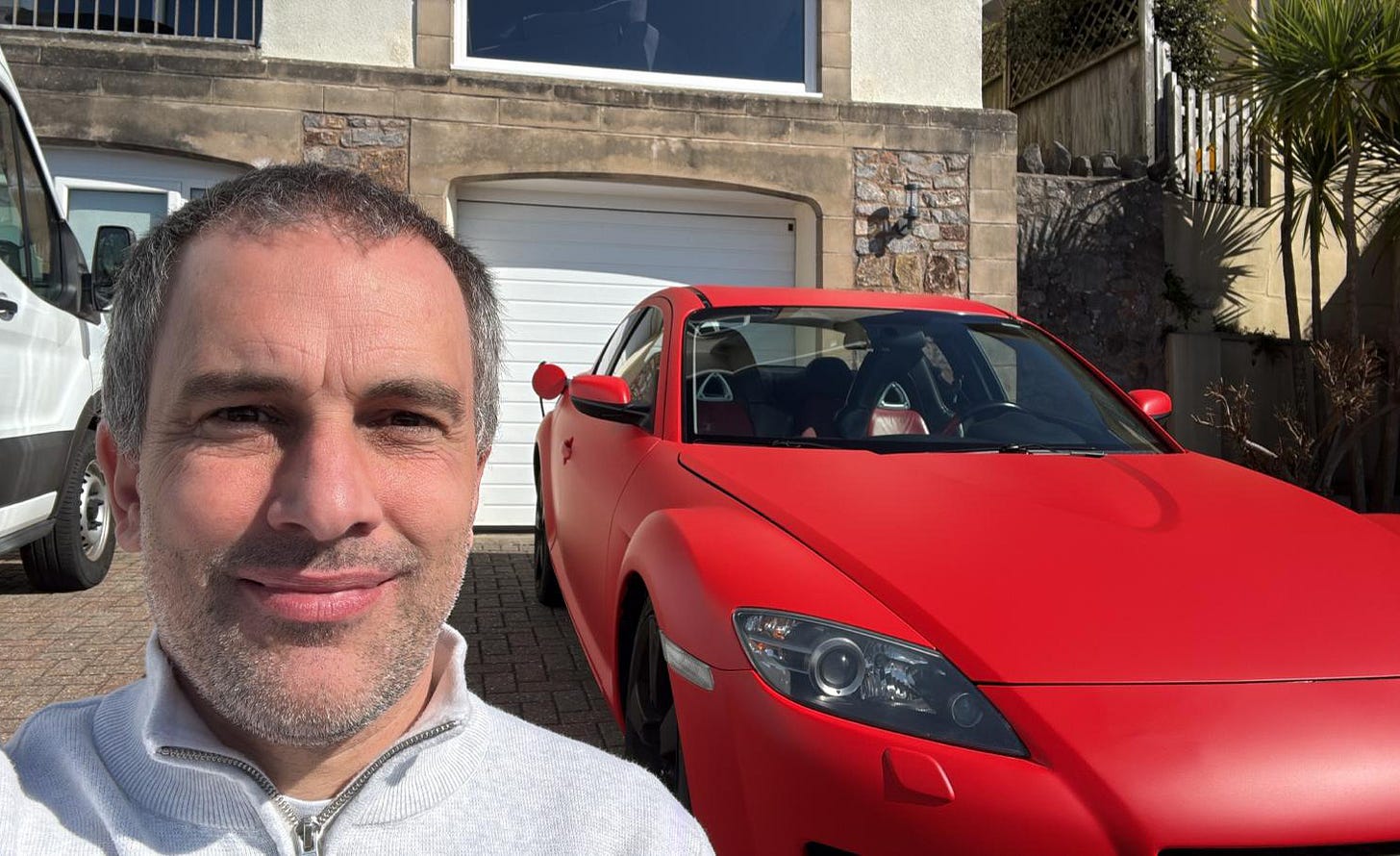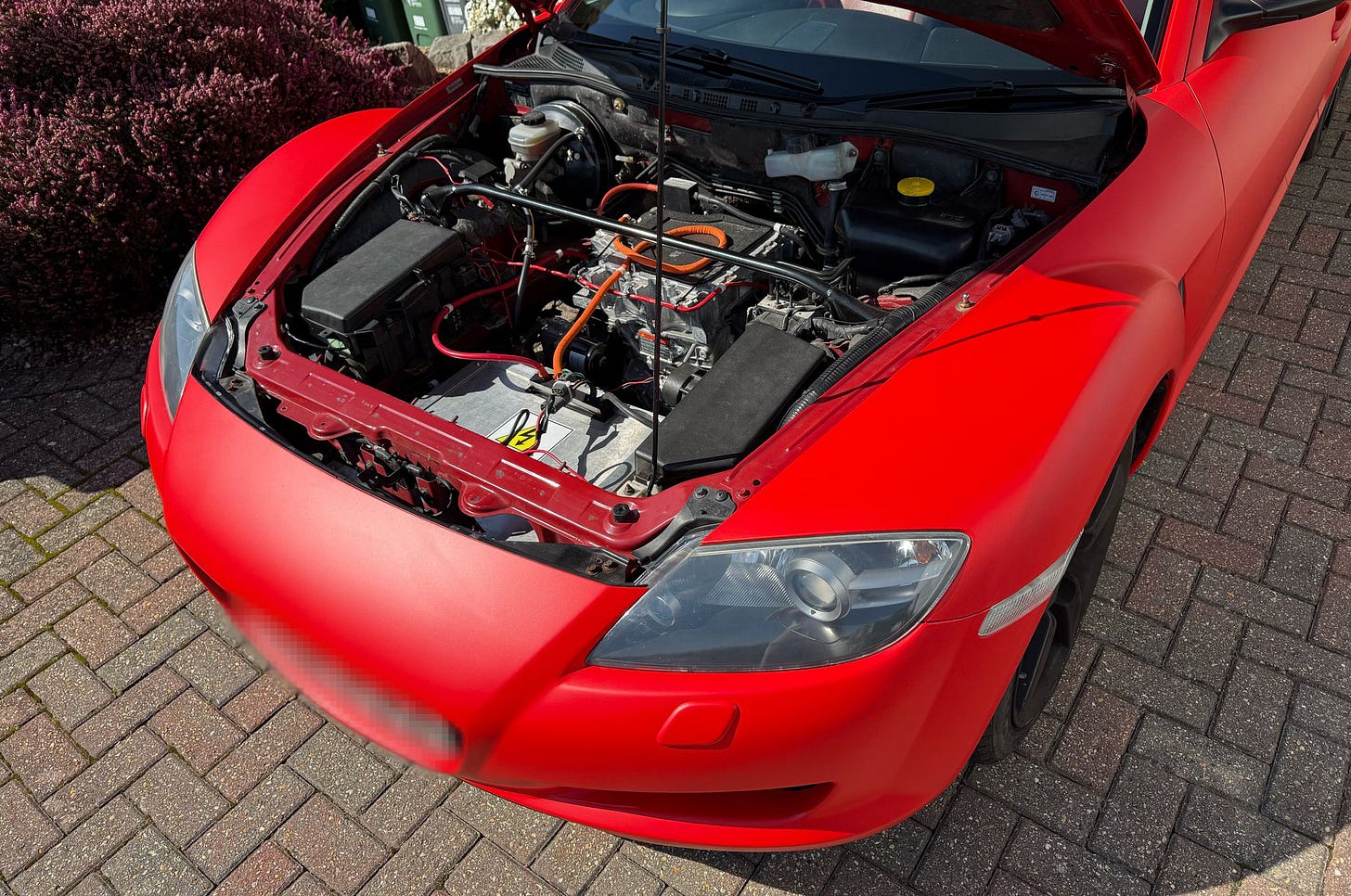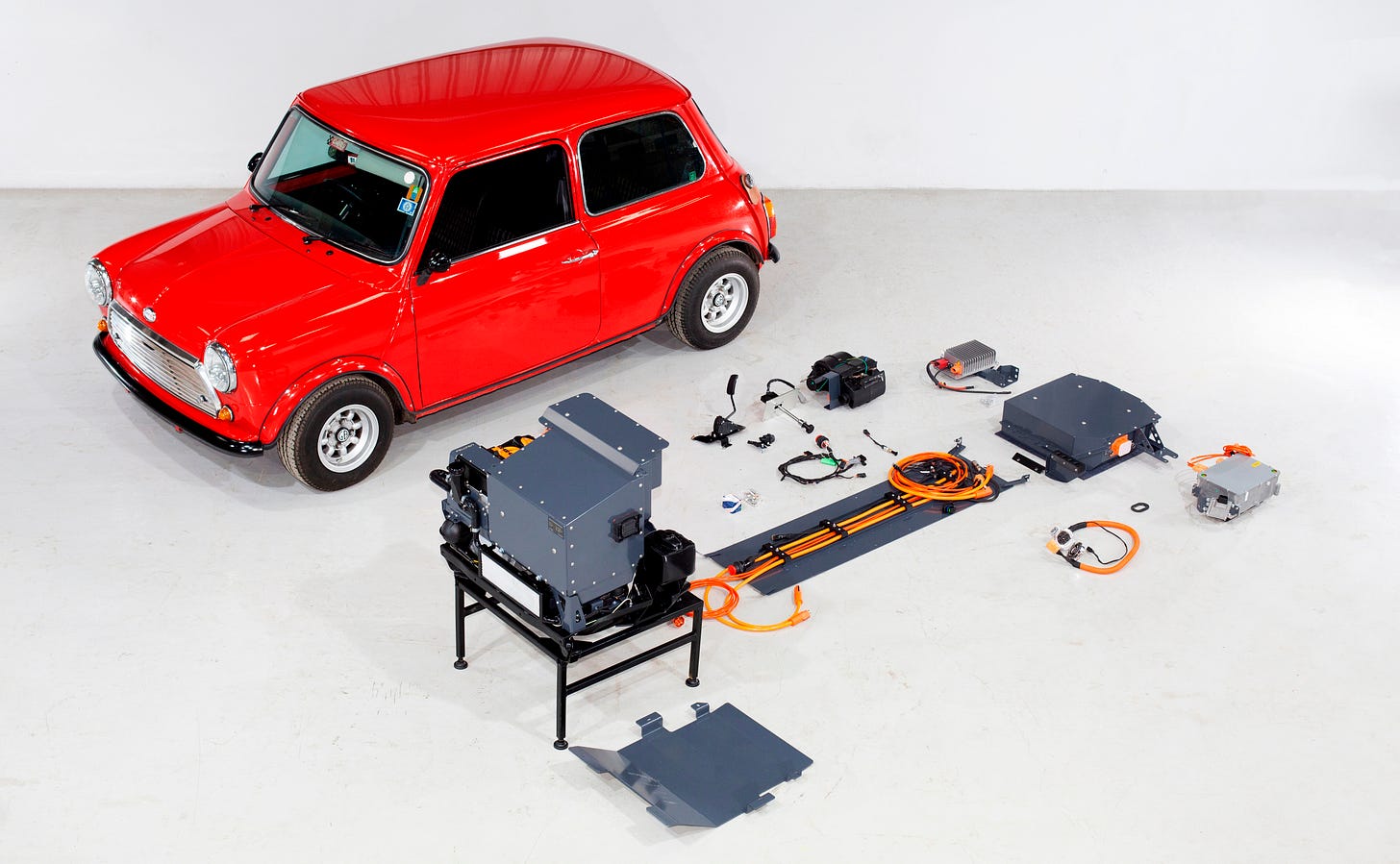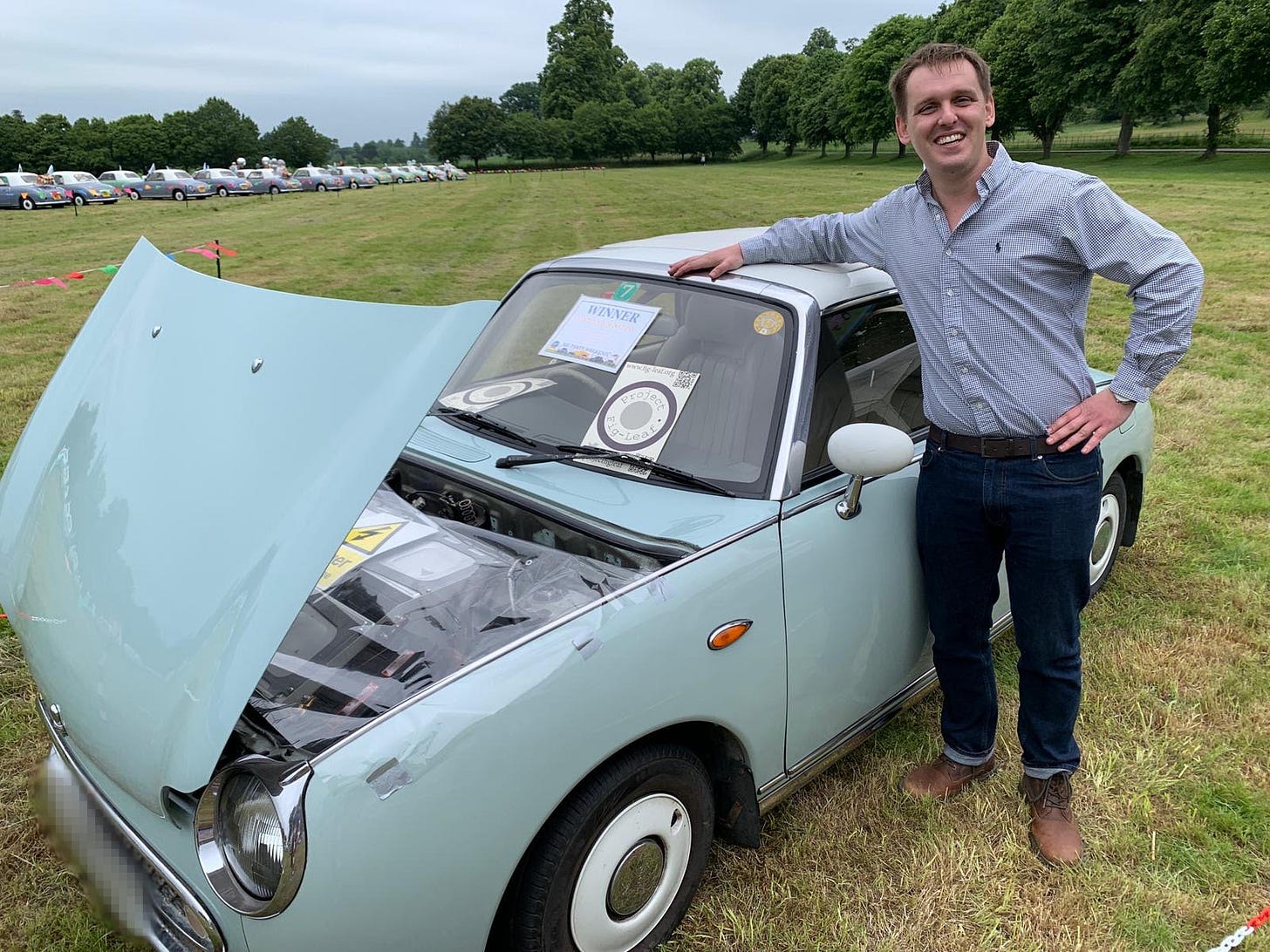‘We should convert more fossil fuel-powered cars into EVs’
It's a growing, yet still somewhat niche, industry
The first time Dave Blackhurst took his newly electrified Mazda RX-8 for its annual MOT roadworthiness test, he was peppered with questions. “Did you do this?” asked the inspector, poring over the large electric motor, instead of the expected fossil fuel-guzzling engine. “Oh yes,” replied Blackhurst.
“Was it a kit?” the inspector then enquired. “No, no. I put it together and I wrote the software.”
Blackhurst, a software engineer in Somerset, had done it all himself, he says. It had taken him months. “They kind of look at you again and go, ‘Wow, that’s cool,’ and then they get on and MOT it,” he recalls today. Blackhurst’s RX-8 has had three MOTs in total now, and passed every one.
Converting fossil fuel-powered vehicles into electric vehicles (EVs) is nothing new. Highly skilled enthusiasts have been doing it for years. And there are more than a dozen companies in the UK alone that offer to do such work for you. But it remains, arguably, a somewhat niche endeavour.
Given the urgency of slashing emissions and extending the life of products for sustainability reasons, some car conversion proponents are now asking why it hasn’t yet become more mainstream.
“I get the feeling that, going forward, we’re going to get caned for driving petrol vehicles,” says Blackhurst. “But [scrapping a car] is an environmental nightmare in its own right. Why are we throwing all this away when it can be converted?”
WARNING: Electric vehicle technology is extremely dangerous and potentially deadly. Modifications should only be attempted by qualified persons.
When it came to electrifying his Mazda, Blackhurst’s background helped him out. He used to race cars and so understood vehicle mechanics pretty well – plus he had some electrical engineering qualifications. But it was still a big challenge largely because of the Controller Area Network (Can) bus, a system that allows various parts of the car to communicate electronically. Classic cars don’t have a Can bus but the technology became standard in new vehicles from around the early 2000s onwards.
After ripping out the old engine, Blackhurst knew he would have to conquer the RX-8’s Can bus, which was a bit like unpicking a very complex lock. Otherwise, his interfering with the car’s innards would end up triggering all the warning lights on the dashboard – which would definitely fail an MOT. “It makes it a lot harder to convert,” says Blackhurst. “Every manufacturer essentially has their own language.”
After a lot of trial and error, he managed to decode the Can bus and write software to manage the data flying around inside the vehicle. The project also involved working with extremely powerful electronics. Just one battery cell can pump out a high level of electrical current, Blackhurst stresses, meaning there is a potential risk of injury or even death: “It’s not to be messed around with – because it will kill you.”
Tax brakes
Once the conversion was complete, he had to re-register the car but there were hurdles there that he couldn’t overcome. For example, it’s not currently possible to change the classification of a car’s power source post-manufacture, at least in the UK. So the RX-8 is still officially registered as a petrol car, even though it isn’t.
This means Blackhurst isn’t eligible for the tax breaks that apply to EV owners. He’s lobbied his local MP on this point but, so far, hasn’t seen any change in the rules around registration and taxation for converted cars.
That hasn’t stopped him enjoying the results of his hard work, though. “It’s my little run-around that I drive around town,” he says of the RX-8. “I drive it constantly.”
Between 2014 and 2024, a total of 222 cars were converted to electric power from other fuel sources in the UK, according to the Driver and Vehicle Licensing Agency (DVLA).
In recent years, a swathe of companies offering to convert customers’ petrol or diesel vehicles to EVs have sprung up worldwide. The cost of a conversion could be as little as a few thousand pounds, though can easily rise into the tens of thousands depending on the class of vehicle and the specifics of the job. Given that some conversions can be so expensive, it’s little wonder why they haven’t become more popular yet.
UK firms operating in this area include Electrogenic, Silent Classics, Electric Car Converts and Fellten. A spokesman for the latter insists that interest in EV conversions is growing: “The last 24 months, in particular, have shown the industry reaching maturity, with an increasing demand for high-quality, scalable solutions.” Bristol-based Fellten ships “dozens” of conversion systems every quarter, he adds.
Founder of Electric Car Converts, Barnaby Birkbeck, says his company, which specialises in Land Rover conversions, has electrified around 40 cars to date. New customers are currently added to a 10-month-long waiting list. “I don't think popularity is increasing, we just have a steady flow of bookings,” he says.
Stop-start
There is also the David Beckham-backed Lunaz, based at Silverstone Park in Northamptonshire. Lunaz was forced to halt production last March, however. At the time, managers blamed this on the government’s decision to delay banning the sale of petrol and diesel vehicles in the UK to 2035, rather than 2030. Lunaz restarted operations two months later, in May 2024.
Lunaz is one of several firms that have also converted commercial vehicles into EVs. Examples of such vehicles that you can find around the UK include everything from black cabs to bin lorries.
Some car owners might decide to buy a kit that could make their car conversion easier. Ford has even released an electric motor that slots neatly into some of its vehicles.
For a some, it’s simply the thrill of turning their favourite car into an EV, rather than giving it up, that makes a conversion so rewarding. James Brown, an airline pilot who lives in Oxfordshire, decided to modify his partner’s beloved Nissan Figaro into an EV a few years ago. “Its engine had died and there was lot of work needed doing to it,” he recalls. “I thought, ‘Why not give it a go’ – [my partner] gave me the OK.”
Brown attended a course that explained some of the finer points of the conversion process and he managed to get the car running after installing a Nissan Leaf EV battery in it.
After much hard work, he was able to show off Project Fig-Leaf, as he called it, at the Nissan Figaro 30th Anniversary Event in Warwickshire back in 2021. However, Brown still can’t drive his electrified Figaro on public roads as he’s yet to re-register it with the DVLA.
“I’m not going to rush into it – I want to make sure that everything’s done to their satisfaction,” he says, adding, “I do see a future in this for people doing this with their own cars.”
Blackhurst agrees. I ask whether there might be a risk in trying to extend the life of a car and pushing its mileage ever higher. He replies that cars built during the last decade or two are more dependable and last longer than their 20th Century ancestors – they don’t rust so readily and their components fail less often, he says.
“I’ve got a 10-year-old Lexus outside and it’s amazing, it’s absolutely brilliant,” adds Blackhurst. “The only reason I’m going to change that is to get an electric car – but what I really want is for [the Lexus] to be electric.”
Further reading on this week’s story
Both Dave Blackhurst and James Brown have documented their car conversion experiences on YouTube.
The RAC, a UK-based insurance and roadside assistance firm, has a guide to EV car conversions on its website.
While conversions initially gained traction with classic car owners, some people are even turning brand new fossil fuel-powered vehicles into EVs.
EV Builder’s Guide has a list of firms around the world that can carry out electric car conversions.
Update: Added data from the DVLA on car conversions. Also added a note on the cost of conversions.
Thanks for reading! If you enjoyed this story, don’t forget to share it with your friends and colleagues. You can also subscribe to The Reengineer and follow me on Bluesky.








